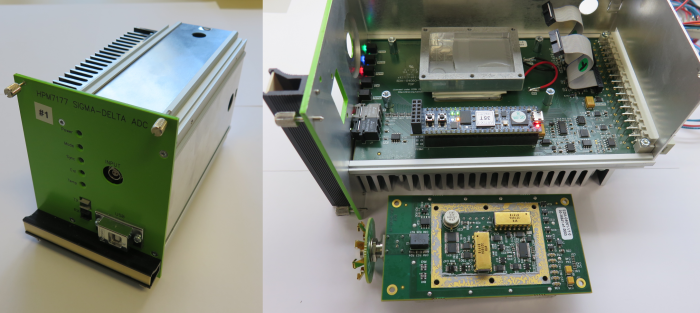One of the key elements of the LHC high-luminosity upgrade project is the replacement of the magnets that focus the beams near the interaction points of ATLAS and CMS, where particle collision occurs. The new higher field magnets also call for higher precision powering, which is strongly dependent on the performance of the electric current measurement chain. The CERN Electrical Power Converters Group developed a new metrology-grade digitizer, part of that high-precision measurement system. The new digitizer will be employed in the power converters of the Inner Triplet quadrupoles and separation/recombination dipole magnets of the HL-LHC. This Analog-to-Digital Converter (ADC), named HPM7177, was designed at the High-Precision Measurements section and first tested in 2019.
The main goal of the High-Luminosity LHC (HL–LHC) project [1] is to increase the luminosity of the LHC beam, both instantaneous and integrated. For that purpose, the project foresees the replacement of several magnets in the LHC. Among the most important are the Inner Triplet (IT) quadrupoles on each side of the interaction points of the ATLAS and CMS experiments. The IT quads contribute to increasing luminosity by reducing the beam size at the interaction point. This improvement requires a fine tuning of the beam parameters, which translates into unprecedented performance requirements for the magnetic field stability and accuracy and, consequently, for the electric current that generates it [2].
To power magnets in particle accelerators, electrical power converters are used. They are commonly employed as controlled current sources. At CERN, power converters use high-precision current feedback loops, implemented digitally, to deliver the current to the magnets. As a consequence, both the reference current and the measured current need to be provided in the digital domain. The reference current is sent digitally by the control room. However, the current in the magnets is sensed in analog by means of a Direct-Current Current Transformer (DCCT) and therefore needs to be converted into a digital code. A high-precision ADC is used for that purpose.
The requirements for the power converters are unprecedented in terms of current stability, noise, and repeatability [2]. Since power converter performance depends greatly on the quality of the measurement used for the feedback, the DCCT and the ADC are crucial for delivering the required precision. Short-term stability (1mHz < f < 100mHz) of 0.05ppm (parts per million) rms, 12h stability of 0.2ppm p-p (in isothermal conditions) and linearity of 1ppm, are just a few of the challenging requirements imposed on the ADCs [3].

The HPM7177 digitizer, an entire stand-alone measurement system, was developed to answer these constraints. Its core element is a commercial high-resolution ADC integrated circuit, selected after an extensive market survey [4] and test campaign. The digitizer employs precision circuits for the scaling of the analog signals. Digital logic functionality is implemented in a field-programmable gate array (FPGA), which takes care of the ADC chip initialization and readout, the communication and synchronization protocol, as well as the built-in calibration and self-test features of the system.
Different aspects of the HPM7177 design address the challenges generated by the need for stable measurements on the timescale of a typical LHC cycle. Electronic components exhibit various kinds of noise, including the omnipresent 1/f or “flicker” type with spectral density rising at low frequencies. To minimize low-frequency electronic noise, the voltage scaling circuits employ bulk metal foil resistors and auto-zero operational amplifiers. Ultimately, the performance on longer timescales is limited by the voltage reference, which is the best one presently available on the market. External influences such as temperature variations and electromagnetic interference (EMI) also affect the measurements.The digitizer has very low temperature-dependent drift on the order of tens of ppb (parts per billion) per degree Celsius, achieved by active temperature stabilization of the sub-module that contains all precision circuits. On the system level, multiple measures are taken to ensure EMI immunity, since the ADCs often have to operate in a potentially noisy environment near power converters.
A characterization campaign, carried out using reference equipment from the standards laboratory at CERN, proved that HPM7177 meets the most challenging requirements for the HL-LHC project. To gain more confidence on and knowledge of the device, the team of developers have planned to collaborate with the German national institute of metrology (PTB – Braunschweig) to characterize the digitizer using their 10V Programmable Josephson Voltage Synthesizer [5]. This system generates test voltages with ultimate stability using the Josephson effect – a quantum phenomenon in superconductors that links frequency to voltage and is currently used for the practical realization of the Volt in the International System of Units (SI).
The full design documentation of the HPM7177 is available under the CERN Open Hardware License [6].
References:
[1] G. Apollinari, I. Béjar Alonso, O. Brüning, P. Fessia, M. Lamont, L. Rossi, and L. Tavian, “HL-LHC Technical Design Report,” Tech. Rep. EDMS n. 1723851 v.0.71, CERN, Geneva, 2016. https://edms.cern.ch/document/1723851/0.71
[2] Update of beam dynamics requirements for HL-LHC electrical circuits. CERN-ACC-2019-0030. Gamba, Davide (CERN) ; Arduini, Gianluigi (CERN) ; Cerqueira Bastos, Miguel (CERN) ; Coello De Portugal - Martinez Vazquez, Jaime Maria (Universitat Politecnica Catalunya (ES)) ; De Maria, Riccardo (CERN) ; Giovannozzi, Massimo (CERN) ; Martino, Michele (CERN) ; Tomas Garcia, Rogelio (CERN) https://cds.cern.ch/record/2656907?ln=en
[3] HL-LHC Power Converter, ADC and DCCT Requirements; Miguel Cerqueira Bastos, CERN EDMS 2048827 https://edms.cern.ch/document/2048827/2
[4] N. Beev. Analog-to-digital conversion beyond 20 bits. Proceedings of I2MTC-2018, Houston, TX (2018) https://cds.cern.ch/record/2646282/
[5] Josephson Technology at PTB-Braunschweig https://www.ptb.de/cms/en/ptb/fachabteilungen/abt2/fb-24/ag-243/forschung-243.html
[6] HPM7177 Open Hardware Repository wiki page https://ohwr.org/project/opt-adc-10k-32b-1cha/wikis/

